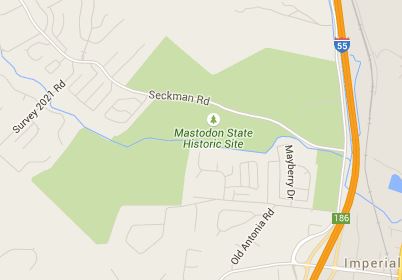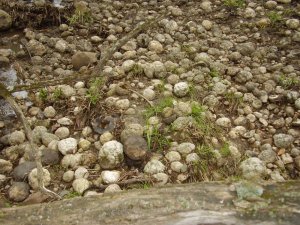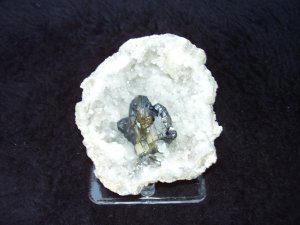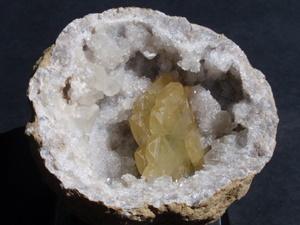|
Having trouble reading this email? View it in your browser. |
 |
CSA News
The Creation Science Association for Mid-America |
Volume 32:7
July 2015 |
|
"It is better to trust in the Lord than to put confidence in man."
Psalm 118:8 (KJV) |
|
In This IssueLynn Lemons Memorial Safari:
|
Lynn Lemons Memorial Safari:
|
| Mastodon State Park.1 |
The site is the home of the Kimmswick Bone Bed, one of the most famous and extensive Pleistocene ice age deposits of fossils, including a number of bones of giant mastodons. Interpretative trails and picnic sites dot the landscape and a museum tells the natural and cultural story of the Clovis culture, which existed in the area before written history. 2
See the article on mastodons, mammoths, and elephants, which reports on some fascinating DNA evidence of baraminology. It begs the question, did all three of these large creatures ride through the Great Flood along with Noah and his family, or does the DNA evidence suggest that there has been some variation within the "pachyderm" kind, since the flood?
Our next stop is just across the Mississippi River, near Collinsville, Illinois. There are campsites and motels in the area, which are convenient to the Indian mounds. More information on campsites and motels is forthcoming for safari registrants.
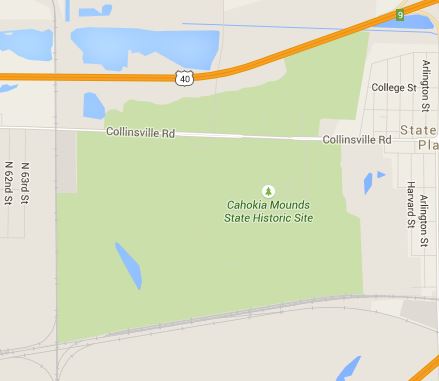
| Cahokia Mounds State Historic Site.3 |
The Safari will next visit the Cahokia Mounds State Park, where early mound builders built an Indian city just east of St. Louis, in western Illinois. The population of the colony there was thought to be larger than the city of London, England at that time. Many earthen mounds were built in the area, and nearby.

| Monk's Mound. |
Cahokia Mounds is the largest and earliest pre-Columbian settlement north of Mexico. It was occupied primarily during the Mississippian period (800-1350), when it covered over 1,600 hectares (3,950 acres) and included some 120 mounds. It is the pre-eminent example of a cultural, religious, and economic center of the Mississippian cultural tradition, which extended throughout the Mississippi Valley and the southeastern United States. This agricultural society may have had a population of 10,000-20,000 at its peak between 1050 and 1150. Cahokia is an early and exceptional example of pre-urban structuring.4
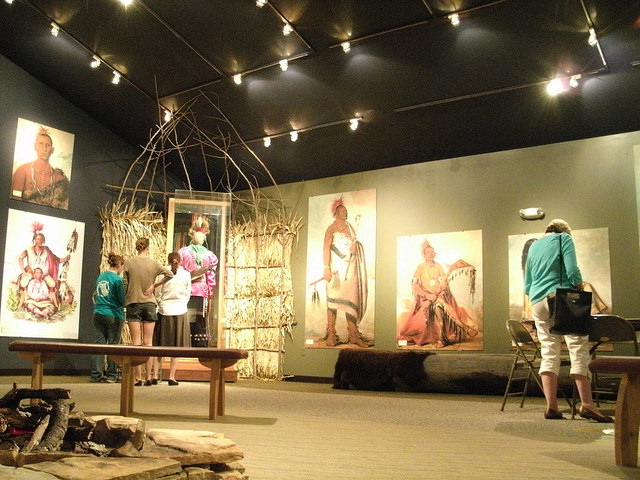
There is an interpretive center where visitors can see and hear the archeologists' account of these advanced people. There are guides who take walking tours on the trails which crisscross the park.
Camping facilities and motels are abundant in this area.
See the article on the migration of North American natives, for a look at the possible connections between the Mound Builder Tribe and early European people.
The third stop on the Safari is known for abundant geodes. Rock hunters will find more Keokuk Geodes than they can carry in this locale.
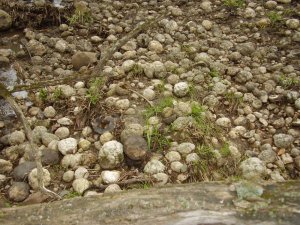
|

|
Although geodes of different kinds are found all over the world, the greatest abundance and variety are found in the outcropping of the Mississippian lower Keokuk bed within a 70 mile radius of the intersection of the Mississippi and Des Moines Rivers. Southeastern Iowa is one of the state’s best Geode collecting areas. Geode State Park in Henry County is named for the occurrence of the geode.
The large number of mineral inclusions and the exquisite crystal groups that they form have made the Keokuk Geodes the most beautiful and the most sought-after of all geodes by museums and collectors the world over. The most common size of Keokuk Geodes is about 3-4 inches across, and some reach 2 feet across and larger. Most Keokuk Geodes occur within a 35 mile radius of Keokuk.6
The roundish hollow crystal-filled rocks are collectively referred to as "Keokuk Geodes," having been named after the city of Keokuk, Iowa located in the heart of the collecting area. Most of the geodes are derived from the lower Warsaw Formation, a widespread rock unit of Mississippian age. Calcium carbonate and clay muds deposited in a shallow sea (according to evolutionists, about 340 million years ago) were subsequently lithified to form the shales, shaley dolomites, and limestones. Geodes can be dug out of exposures of the lower Warsaw Formation where they are concentrated in certain layers. Loose geodes can also be collected in stream channels where water has eroded the rock.
Participants in CSA safaris should register on the CSAMA website so that planning for the size of the party can be done.
Please refer to the accompanying article on Keokuk geodes in this issue for more information, and to see a few sample photographs of geodes.
1 https://mostateparks.com/map/mastodon-state-historic-site
2 Ibid.
4 http://whc.unesco.org/en/list/198
5 http://www.firstcrackgeodes.com/keokukgeodes.html
6 http://www.keokukiowatourism.org/geode.htm
Ω
August Monthly MeetingAugust 4th, 2015
Compromisemoderated by Kevin Anderson Compromise can be a good thing. For example, it can help mend a relationship. But what about a relationship between truth and fiction? A compromise in that case creates only fiction. Many who attempt to find a compromise between "science" and "religion" end up deferring to man's wisdom instead of God's truth. This is because any division between science and religion portends a false dichotomy: a compromise between the real science of God's truth about the history of our origin, and man's best speculation on our origin without God. The result is the exchange of truth for a lie. (See Romans 1:25.) Ω |
Monthly Meetings2015(1st Tuesday of each month; content subject to change; no signup or registration necessary.) For a more detailed discription of the monthly meeting topics visit www.csama.org.
|
CSA Monthly Meeting LocationWestbrooke Church For detailed Monthly Meeting information: |
Another of the Created Kinds: Elephantidby Douglas Roger Dexheimer This coming Labor day, 2015, CSAMA will have a creation safari to eastern Missouri. The first stop on this safari will be the Missouri Mastodon Park, south of St. Louis. 
As you can see in this artist's rendition, the mastodon is similar in shape and smaller in size to today's African bull elephant, and also resembles the wooly mammoth seen in cave drawings in Europe. The thought arises… are these large creatures all part of the same created kind? Remember how our recent baramin articles centered on the possibility of interbreeding? Readers of this newsletter will recall a number of articles that probed into the genetic background of a number of creatures: canines, felines, bovines, equines, etc. At the risk of falling into the same heresy that pervades evolutionary biology, let us momentarily consider the concept of homology, which is defined as "a fundamental similarity based on common descent, or a structural similarity of two segments of one animal based on a common developmental origin."1 It appears as if these creatures are of the same kind, but since two of the three are extinct, interbreeding experiments are not possible. Another way to determine that is to examine the DNA of the creatures. I have corresponded with Dr. Robert Carter, the genetics specialist for Creation Ministries International (CMI). Regarding the DNA of these large creatures, Dr. Carter advises:
The following is an excerpt from an article which Dr. Carter so kindly sent me.
I went online with Google.com and found a secular article with a diagram claiming that these beasts “evolved” from a common ancestor. 
Finally, I went to the CMI website, and searched for “mastodon.” I came up with an article entitled, "Ancestors, selection and Nepalese ‘mammoths,’ ” which concludes: 
I would also invite your attention to an article by Jonathan Sarfati "Mammoths, the riddle of the Ice age".5
This is confirmation that the time span between the separation of the mastodon, the mammoth, and modern elephant is short, practically a matter of a few hundred years. If you wish to see examples of mastodon skeletons nearby, join our safari to eastern Missouri and western Illinois, coming up this Labor Day Weekend. 
Here’s is a webpage that shows a map of the park: Camping facilities are not available in the immediate area. It is probably best to visit the Missouri Mastodon Park as early in the day as possible, leave when the park closes at 5:00, and then travel to the abundant campsites in western Illinois, near the Cahokia Mounds State Park. Travel time from Kansas City via I-70 (with multiple construction zones) is about 4 hours (257miles). More relaxed travel time via US 50 to see the Missouri countryside: about 5 hours (270 miles). 1 http://dictionary.reference.com/browse/homology 2 Email correspondence from Dr. Robert Carter, 3 June 2015. 3 Roca pdf file attached to above email. 4 http://creation.com/heard-of-elephants 5 http://creation.com/mammoth-riddle-of-the-ice-age 6 Ibid. Ω |
|
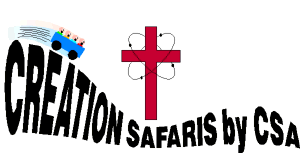
|
Cahokia Mound Builders Indian Tribeby Douglas Roger Dexheimer
A THRIVING ANCIENT METROPOLIS According to archaeological finds, the city of Cahokia was inhabited from about A.D. 700 to 1400. At its peak, from 1050 to 1200, the city covered nearly six square miles, and 10,000 to 20,000 people lived here. Over 120 mounds were built over time, and most of the mounds were enlarged several times. Houses were arranged in rows, and around open plazas, and vast agricultural fields lay outside the city.2 The mound building Indians were agrarian, grew corn and beans for their own people, and traded these goods with remote tribes for needed materials, such as flint in the north, and coral in the south. AGRICULTURE
Specialization in farming and hunting meant that there were others who built and protected their city, others who devoted their time to handcrafts, and yet others dedicated to watching the sun, and plotting out the directions of sunrise and sunset at equinoxes and solstices. Today, these people would be called prehistoric astronomers, or skywatchers. ASTRONOMERS 
The above illustration shows the construction of the circle of poles. Note the direction of the shadows cast by the poles in the sunlight. An extensive account of the discovery of the post holes, and their supposed significance are provided at this website: http://cahokiamounds.org/explore/cahokia-mounds/woodhenge. 
The above photo was taken from near the center pole, looking eastward toward Monk’s Mound. Unfortunately, the photo was taken on a cloudy day, so the sun and the shadows cast by the poles are not apparent. There are three poles with white wrapping, signifying the direction of the sunrise at summer solstice on the left (north), equinox due east, and winter solstice to the right (south). This archeological, astronomical structure is named after a similar wooden structure located in England. The term “henge” is often incorrectly thought to mean a circular structure of stone. In fact, henge refers to an enclosed structure made of compressed earth containing a ditch on the inside of the bank, giving the perception of keeping something inside the enclosure, rather than keeping something, or someone, outside of it.4 The ages of the English Woodhenge precede the North American Indian Woodhenge .5 This suggests that knowledge of astronomical alignments may have been carried with the tribe migrating from northern Europe to North America. MIGRATION Several years ago, this writer prepared a term paper for a course in Genetics locally at Johnson County Community College. The Y-chromosome of migrating people groups studied by Dr. Spencer Wells was compared to the Table of Nations that is found in Genesis chapters 9 & 10. Dr. Robert Carter of Creation Ministries International (CMI) discussed this study by Dr. Wells when he compared the mitochondrial DNA of the people groups. You can see the paths of people groups A, B, C, and D from Asia to the Western Hemisphere, or New World.  Notice the dotted line connecting the “X” of northern Europe to the “X” in midwestern America. This backs up the next two references in National Geographic and Nature, that there is a strong connection with northern Europeans to North Anerican native Indians.6 I discovered that the paths of human migration around the earth shown above, agree to a remarkable extent with the Table of Nations in Genesis. There is one arrowhead missing from the map. It should show the migration from the Middle East -- Babel -- towards Africa, not out of Africa, as is commonly taught by secular evolutionists. This detail was discussed by CMI geneticist, Dr. Carter:
AFTER THE FLOOD
In addition to the above findings by Dr. Carter, there is recent DNA evidence from secular scientists, that as much as 1/3 of Native American DNA is closely linked to northern Europeans "This study changes this idea because it shows that a significant minority of Native American ancestry actually derives not from East Asia but from a people related to present-day western Eurasians," Willerslev said. "It's approximately one-third of the genome, and that is a lot," he added. "So in that regard I think it's changing quite a bit of the history."9 While the land bridge still formed the gateway to America, the study now portrays Native Americans as a group derived from the meeting of two different populations, one ancestral to East Asians and the other related to western Eurasians, explained Willerslev, whose research was published in the November 20th edition of National Geographic. Another recent article corroborates this discovery. "Evidence from DNA of Upper Palaeolithic Siberian genome reveals dual ancestry of Native Americans"11
In the above articles, feel free to drop zeros from the ages. I.e., change “24,000” to “2,400,” for example. As usual, scientists like to throw in lots of zeros for effect. They do not have evidence for the ages, just guesses. Our dates are not guesswork, but are based on biblical evidence. Join us on the Lynn Lemons Memorial Safari this coming Labor Day Weekend. (Remember, all safari participants must register in advance, on the CSA Safari page.) 1 http://cahokiamounds.org/explore/ 2 http://cahokiamounds.org/learn/ 3 https://en.wikipedia.org/wiki/Indigenous_peoples_of_the_Americas 4 https://en.wikipedia.org/wiki/Bluestonehenge 5 https://en.wikipedia.org/wiki/Woodhenge 6 http://creation.com/noah-and-genetics 7 Ibid. 8 Ibid. 10 Ibid. 11 http://www.nature.com/nature/journal/v505/n7481/full/nature12736.html 12 Ibid. Ω |
Too far away to attend CSA meetings?
|
Help WantedCSAMA is seeking an editor for, and contributors to, our newsletter. If you are a born-again Christian, believe the Bible is the infallible word of God, subscribe to the literal 7-day creationist viewpoint, if you have researching and writing skills, and if you have suitable ideas for articles to contribute to our publication and can meet a monthly deadline schedule, please contact the newsletter webmaster via the link at www.csama.org. |
Join and Support CSA Thousands of people receive CSA News, which is free for the asking. |
| Write or call: | Creation Science Association for Mid-America PO Box 13503 Overland Park, KS 66282-3503 Phone (Bob Farwell): (816) 246-4517 |
Keokuk, Iowa Geode Huntby Douglas Roger Dexheimer This is a supplemental article associated with the 2015 Lynn Lemons Memorial Labor Day Safari. We’ll discuss the Keokuk geodes found in the Warsaw formation. This formation is exposed in approximately a 50-mile radius around Keokuk, Iowa. This layer also extends into Illinois and Missouri. Although geodes in this layer are found in 3 states, they are still referred to as "Keokuk geodes."1 There are a number of websites that feature the Keokuk geodes, and how to find them. Here are just a few: 
The Keokuk geode formation is characterized by two distinct geode-bearing layers: a gray shale layer, and a brown, carbonate-rich, clay layer. The lower level is made of a gray shale. The shale is very hard and the geodes do not come out easily. These geodes are very clean on the inside and don't require much cleaning once opened. The geodes can be dug out of the gray shale using rock hammers, chisels, pry bars, sledge hammers, and paleopicks. The second layer is a brown carbonate-rich clay. This layer is much softer than the gray shale. It produces many more hollow geodes. Geodes can be extracted from the brown clay by using a paleopick, rock hammer, or even a small shovel (spade). The geodes in this layer require some cleaning once opened due to some iron and calcium deposits that have coated the quartz crystals during formation. If you're not one to dig, many rivers and creeks in the Keokuk area have cut though these two layers and weathered out the geodes, which can be easily picked up along the bottom of the water way or on rockbars and sandbars.

The special Wheeler-Rex 590 Soil Pipe Cutter (shown above) is the best way to open a geode. The photos on the webpage linked by footnote 5 illustrate the use of this tool. At least one of these special tools will be available on the safari -- no need to buy one of your own, unless you plan to open many geodes. The techniques of opening and cleaning the opened geodes are spelled out in detail on the website.5 If you intend to participate in this safari, please register on the csama.org safari signup page, so that proper arrangements can be made in advance. Some of the best geode "mines" may charge for access. NOTE: PROPER PERMISSION MUST BE OBTAINED BEFORE ENTERING THESE AREAS. MOST OF THE GEODE-BEARING CREEKS AND RIVER ACCESS LOCATIONS ARE ON PRIVATE PROPERTY.1 http://www.keokukiowatourism.org/geode.htm 2 http://www.mcrocks.com/images-2/KeokukGeodePage.html 3 http://www.firstcrackgeodes.com/showcase_specimens.html 4 Ibid. 5 http://www.mcrocks.com/images-2/KeokukGeodePage.html Ω |
|
You are invited to attend all of the monthly meetings, and as many of the safaris as you can fit into your schedule. Pass the word. Tell your friends and neighbors about CSAMA and our activities. Show them how to subscribe to the CSAMA Newsletter. Never miss an opportunity to debunk the "millions-of-years" notion that evolutionists insist is necessary for life as we know it. |
We’d love to hear from you!If you have questions or comments, or if you have suggestions for making our newsletter better, please feel free to contact us. We’ll do our best to respond to every query. Thank You! The Editor (Use the editor link on the contact page at www.csama.org.)
|
|
Scripture quotations marked (ESV) are from The Holy Bible, English Standard Version® (ESV®), copyright © 2001 by Crossway, a publishing ministry of Good News Publishers. Used by permission. All rights reserved. |
Contact & other links
|
|
Quick unsubscribing link at the bottom of the most recent newsletter. |
